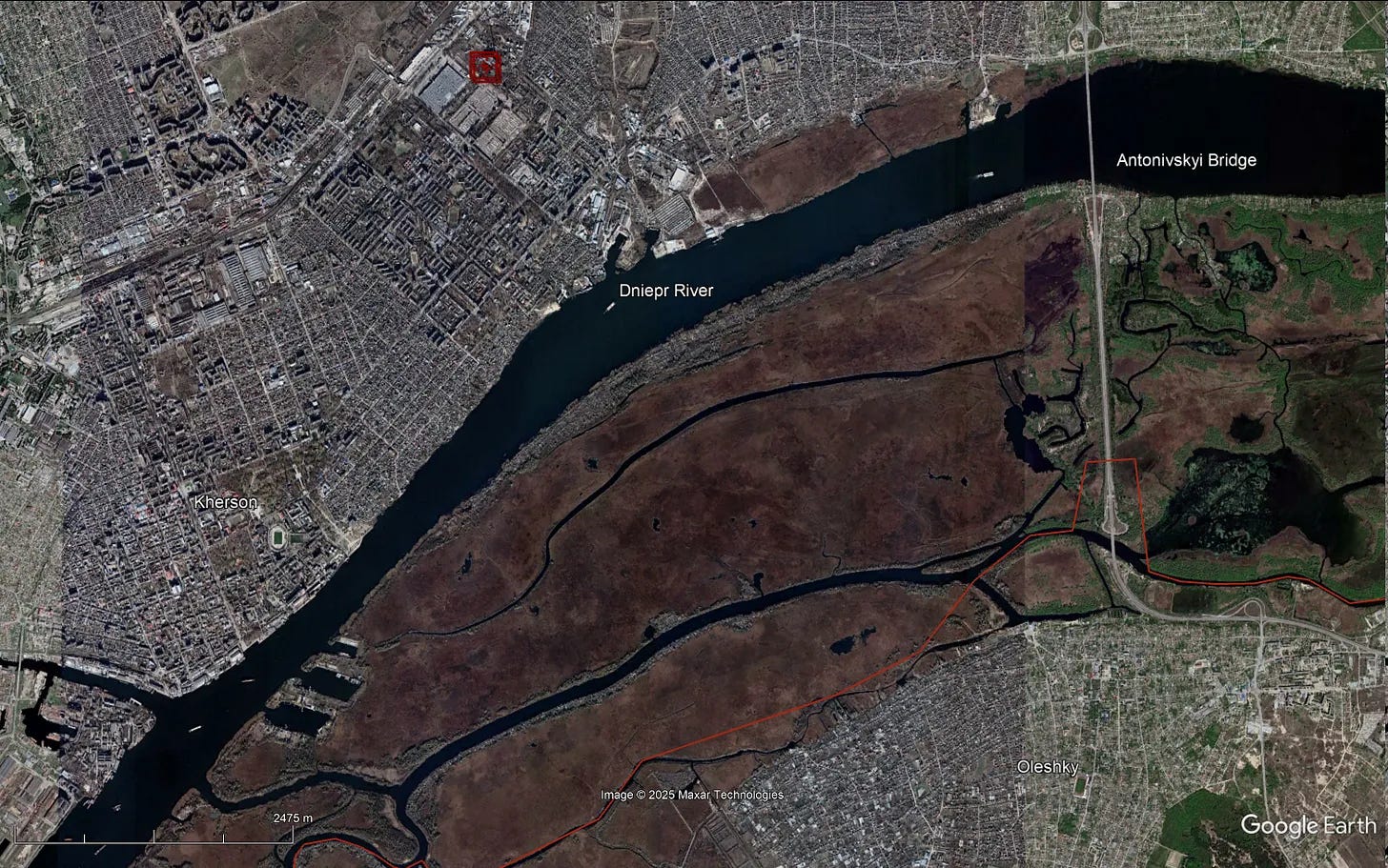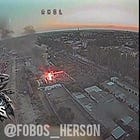Russian Armed Multirotor Drones Used To Target Electricity Generation Equipment Inside Power Plant Building In Pioneering Attack
🇷🇺 🇺🇦
Viewing so-called “First Person Video” (“FPV”) drone footage from the Russia-Ukraine War is often a quite sordid affair. There are, however, several “genres” of “FPV” drone footage that are not only more palatable to non-sadistic audiences by virtue of not (directly) depicting the injuring or killing of any human beings but by offering a window into the new options—and new threats—enabled by technological change. One such “genre” is the employment of armed “FPV” drones, typically of the multirotor as opposed to the fixed-wing variety, against fixed—stationary—structures of various types. This dynamic is best characterized as the highly surgical micro-level targeting of fixed—stationary—sites, including critical infrastructure. While severely limited in terms of both range and destructive effects, technological change in the form of low-cost and plentiful armed “FPV” multirotor drones weighing just several kilograms allows militaries—and non-state actors—to attack an incredibly and unprecedentedly large and diverse (potential) target bank that was previously not possible due to the qualitative and/or quantitative limitations of strike capabilities broadly conceived.1
A Russian "First Person Video” (“FPV”) armed multirotor drone unit associated with the Russian Army’s 18th Combined Arms Army is currently operating on the left (eastern) bank of the Dnieper River opposite the Kherson metropolitan area. This unit, “FOBOS," is not only attacking a range of military and dual-use targets in the Kherson metropolitan area but is also undertaking the very surgical micro-targeting of fixed—stationary—local energy storage, electricity generation, local energy distribution, and electricity transmission facilities.
I recently covered this Russian armed “FPV” drone unit’s targeting of the electricity transmission facilities located next to the Kherson thermal power plant:
I covered some additional footage of such attacks in a separate post:
The “FOBOS” armed “FPV” multirotor drone group is also targeting petrol/gas stations in the Kherson metropolitan area. I covered this dynamic in a recent post:
It is important to note that other Russian armed “FPV” multirotor drone units have also been targeting petrol/gas stations elsewhere in Ukraine. I covered this in a recent post:
While the above incidents amounted to the conceptually innovative employment of armed “FPV” multirotor drones of both the radio frequency (RF) and fiber optic (FO) uplink/downlink variety to undertake the very surgical micro-targeting of fixed-stationary sites, it is often inadequate to attack the exterior of a facility. Armed “FPV” multirotor drones are severely limited in terms of range-payload and are, in practice, restricted to a small payload that weighs no more than several kilograms. High explosive warheads of such size have a very limited destructive radius. While armed “FPV” multirotor drones, particularly those of the FO uplink/downlink variety, can be carefully maneuvered to hit a very specific part of a target structure in a very surgical manner, critically important equipment and other lucrative targets can be functionally encased inside a building. The Russian “FOBOS” group has recently undertaken a pioneering attack in which multiple armed “FPV” multirotor drones were used to blast an opening into the main building of the Kherson thermal power plant so that another armed “FPV” multirotor drone, seemingly of the FO uplink/downlink variety, could fly inside the building to surgically attack one of the generators.

The above video from the Russian “FOBOS” group amounts to a novel sight for even the most seasoned observers of the Russia-Ukraine War and military dynamics worldwide more generally. While such a strike and concept of operations has been a possible and plausible undertaking from the day the first armed “FPV” multirotor drone of the FO uplink/downlink variety was used in combat, there have to date been relatively few documented cases of FO uplink/downlink multirotor drones operating inside semi-enclosed or near-totally enclosed structures. Simply put, the above video offers a great example of the lag that is often encountered between what is possible and plausible as a result of technological change, on the one hand, and what has been executed in the real world with documentary evidence to boot. Serious analysts focusing on any issue area must not only stay up to date on events that have already come to pass but also develop a sense of what is both possible and plausible. Rash empiricism, which entails waiting for reality to hit one in the face, makes for a poor analytical approach, and the relevant personnel in the Russian “FOBOS” group should be credited for what is by every public indication a pioneering undertaking.1
In a post covering the “FOBOS” group’s targeting of the electricity transmission infrastructure outside the Kherson thermal power plant posed on 27 July 2025, which is to say before the “FOBOS” group posted the above video on its Telegram channel, I wrote the following:
Second, the high maneuverability of “FPV” multirotor drones in general and FO “FPV” multirotor drones in particular offers the option of targeting very specific critical equipment at a given facility. The second video included in this video is particularly instructive in that the apparent FO “FPV” multirotor drone could have been used to target the interior of one of the buildings at the Kherson thermal power plant. In so doing, the apparent FO “FPV” multirotor drone could have been used to attack a critical piece of machinery, set fire to a combustible object inside one of the buildings, such as a fuel tank or similar, target a key computer system or key piece of machinery, and even target the skilled and experienced technicians who not only operate such a facility but also repair it following a Russian attack. (emphasis added)
See:
The video of the targeting of machinery inside the Kherson thermal power plant can be described as follows. First, a Russian armed “FPV” multirotor drone flies toward the main building of the Kherson thermal power plant. The building in question has window panes, some of which appear to have been the target of one or more previous attacks. Given the discernible signatures of prior destructive events, it is possible—even likely—that several armed “FPV” multirotor drones were previously used to target these window panes with the aim of creating a suitably sized opening for follow-on armed “FPV” multirotor drones to fly into. It is important to note that the walls of this building are not simply covered in large sheets of glass—there are many window panes and what is likely to be a steel grid-like frame that was likely to have been the primary barrier to flying an armed “FPV” multirotor drone inside the building, not the panes of non-tempered glass.
The video transmitted by the armed “FPV” multirotor drone can only be characterized as a high-definition transmission. This was and remains unusual for inexpensive armed “FPV” multirotor drones other than those of the non-FO uplink/downlink variety in the specific context of the Russia-Ukraine War, given that inexpensive and readily accessible commercial-off-the-shelf (COTS) analogue radio transmitters are very widely employed. The Russian “FOBOS” group has, however, advertised its use of unarmed “FPV” multirotor drones as airborne repeaters/airborne radio relays, which can greatly improve the practicality of operating armed “FPV” multirotor drones of the RF uplink/downlink variety in areas characterized by many line-of-sight (LOS) restrictions, which includes population centers such as the Kherson metropolitan area.
The feed from the first armed “FPV” multirotor drone seen in the video cuts off prior to impact for reasons that cannot be wholly ascertained from the video. While armed “FPV” multirotor drones—which are human-in-the-loop uncrewed aircraft turned munitions—of the RF uplink/downlink variety often encounter a loss of the LOS RF uplink/downlink when descending in altitude, this is often experienced in terms of a rapid and very brief deterioration of the quality of the video transmission—a grainy video followed—followed by the the total loss of the RF uplink/downlink. There is no indication of such a dynamic in the above video, and it is possible—even likely—that the armed “FPV” multirotor drone in question collided with some obstacle, such as a wire, and crashed to the ground.
A second armed “FPV” multirotor drone can be seen attacking the same previously damaged—before the first armed “FPV” multirotor drone was anywhere near the building—section of window panes. Note that the remote human operator selected a very different flight path, presumably to avoid the likely wire obstacle that appears to have resulted in the first armed “FPV” multirotor drone seen in the video crashing into the ground short of its apparent intended target.
The video shows a third armed “FPV” multirotor drone operating with an infrared band sensor. This particular armed “FPV” multirotor drone is very carefully maneuvered at a much slower speed so as to enter the opening created in the window panes by preceding armed “FPV” multirotor drone strikes. The armed “FPV” multirotor drone—a wholly human-in-the-loop uncrewed aircraft-turned munition that responds to the control inputs of its remote human operator—flies inside the main building—which is home to the various types of machinery that are encountered inside a thermal power plant—and then turns left so as to ultiamtely detonate upon impact with a large half cylindrical object that is a electric generator.
The third armed “FPV” multirotor drone that flew inside the main building to surgically attack the hitherto functionally encased—by walls, windows, and a roof—electric generator was likely an armed “FPV” multirotor drone of the FO uplink/downlink variety. While it is possible to operate armed “FPV” multirotor drones of the RF uplink/downlink variety inside large structures—with high ceilings—provided that there is a unobstructed LOS to either the uplink/downlink antenna located somewhere on the ground or an airborne radio repeater/radio relay, it is far more practical to employ armed “FPV” multirotor drones of the FO uplink/downlink variety for such purposes.
It is important to note that this is not the first case of an armed “FPV” multirotor drone of the FO uplink/downlink variety flying inside a building to attack a target, including targets that are fully concealed inside the structure and may not have been previously known to the remote human operator. Consider, for example, the following purportedly recent example of an armed “FPV” multirotor drone of the FO uplink/downlink variety flying inside what appears to be a former factory in the Kherson metropolitan area after a Russian intelligence, surveillance, and reconnaissance (ISR) drone detected a vehicle transporting something to/from this location.
The above video shows an armed “FPV” multirotor drone of the FO uplink/downlink variety approaching the building at a very low speed and very low altitude. After finding an opening of suitable size, the remote human operator has the armed “FPV” multirotor drone maneuver inside the mostly empty building. There are clear indicators of a human presence, including an open-air fire inside the high-ceiling building, which has a very large internal volume and is exposed to the elements due to some combination of disrepair and wartime damage. The remote human operator follows the “clues” discernible in the sensor feed—in a manner that should be familiar to readers who have played video games over the past two decades or so—and finds a room that contains green-coloured crates that likely contained munitions. The armed “FPV” multirotor drone then flies into said room as directed by the remote human operator and seemingly detonates upon impact, which results in the total loss of the video transmission.
It is also important to note that highly surgical targeting inside buildings can also take place in multistory structures such as apartment and office buildings. The following video, which has been trimmed from a longer compilation to exclude sections featuring the targeting of Russian soldiers, comes from the Ukrainian “VORON” drone group and offers an uncommon documented case of an armed “FPV” multirotor drone flying inside a what appears to be a multistory structure.
Note that the video begins with the armed “FPV” multirotor drone operating at an indicated altitude of more than 130 meters (this may be erroneous). The remote human operator has the armed “FPV” multirotor drone navigate the floor, which is home to various forms of military equipment, including motorcycles, before directing the multirotor drone to crash into—detonate upon impact with—a small cache of ammunition (for an automatic grenade launcher).
While some militaries have very small and light munitions—with a very limited destructive radius—in their arsenals that are both highly accurate and highly precise, these tend to be expensive and are highly specialized—non-versatile—munitions. Although armed “FPV” multirotor drones are severely limited in terms of both range and destructive effects, these nevertheless enable the very surgical micro-targeting of not only fixed—stationary—sites but also critically important equipment inside structures. This typically requires the use of armed “FPV” multirotor drones of the FO uplink/downlink variety, which are essentially as inexpensive and plentiful as those of the RF uplink/downlink variety. All things considered, these three videos and the video of the pioneering attack inside the Kherson thermal power plant in particular draw attention to the increasing scope for the surgical targeting of fixed infrastructure and similar facilities located within 30-50 or so kilometers of the frontlines of a conflict.
It goes without saying that it is entirely possible that other Russian and/or Ukrainian units—likely the former, given Russia’s considerable lead in manufacturing and deploying armed “FPV” multirotor drones of the FO uplink/downlink variety—among others, have previously undertaken a comparable attack. If this is the case, no such attack has been widely publicized. It is important to note that armed “FPV” multirotor drones of all types are human-in-the-loop uncrewed aircraft-turned-munitions that provide their remote human operators feedback through an onboard visible and/or infrared-band sensor and accompanying communications uplink/downlink (RF and/or FO). All such attacks are, therefore, recorded, and such footage can be readily disseminated over the internet.





